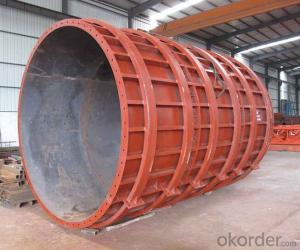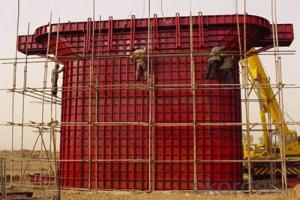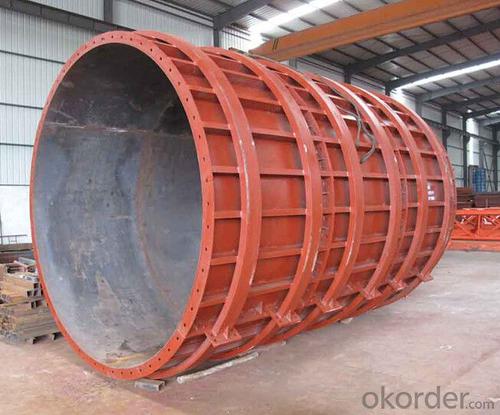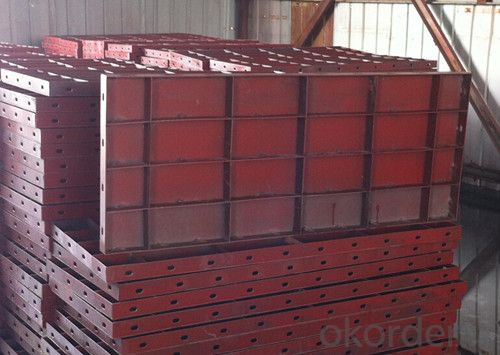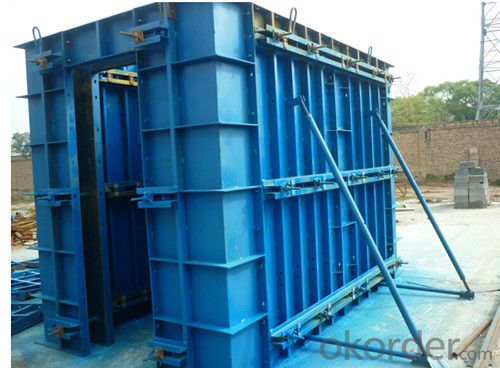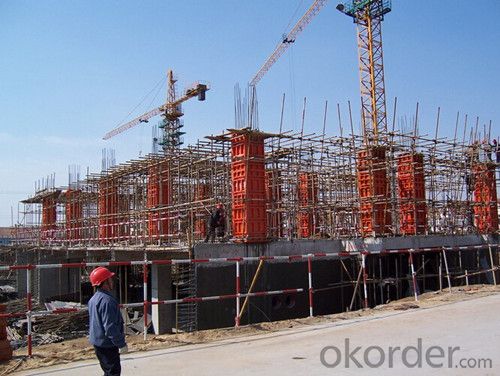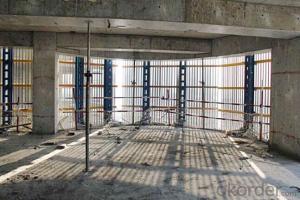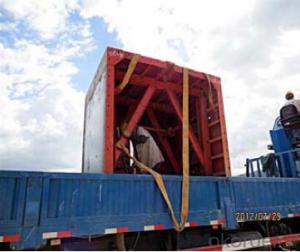Steel Formwork for Tunnel Building with thick Steel Plate
- Loading Port:
- Tianjin
- Payment Terms:
- TT OR LC
- Min Order Qty:
- 100 pc
- Supply Capability:
- 100000 pc/month
OKorder Service Pledge
OKorder Financial Service
You Might Also Like
Introduction for Steel Formwork :
Steel Formwork:used in highway,railway,bridge,tunnel and shearing wall,etc.Our company CNBM which is one of the largest State-Owned Enterprises in China which established in 1984 , has gained the confirmation from the specialist of China Architecture Scence Institute, and has been used by many building operation units and has been highly praised.In 2014, the total turnover volume of CNBM exceeds US$410 billion dollars with a total staff of 180,000. CNBM is listed in the World Top 500 Enterprises !
Characteristic for Wholly Steel Formwork :
1. High Smooth Surface
2. Convex ling for Edge Rib
3. Specialized Connection Pin for Edge Rib Connection
4. High Stiffness for Steel Surface
5. Light Weight for saving producing cost
6. Fast Separate and Easy transport
7. Recycling using
8. Scientific and Reasonable design to meet different working condition
Parameter and Specification :
Code | Size (mm) | Weight (KG) | Code | Size (mm) | Weight (KG) |
P12021 | 1200*2100*55 | 102.96 | P4018 | 400*1800*55 | 28.3 |
P12018 | 1200*1800*55 | 88.4 | P4015 | 400*1500*55 | 23.8 |
P12015 | 1200*1500*55 | 74.15 | P4012 | 400*1200*55 | 19.1 |
P12012 | 1200*1200*55 | 60.11 | P4009 | 400*900*55 | 14.6 |
P10018 | 1000*1800*55 | 76.01 | P4007 | 400*750*55 | 12.3 |
P10015 | 1000*1500*55 | 63.96 | P4006 | 400*600*55 | 9.95 |
P10012 | 1000*1200*55 | 60.11 | P3018 | 300*1800*55 | 20.7 |
P10009 | 1000*900*55 | 39.32 | P3015 | 300*1500*55 | 17.4 |
P9018 | 900*1800*55 | 70.89 | P3012 | 300*1200*55 | 14 |
P9015 | 900*1500*55 | 59.47 | P3009 | 300*900*55 | 10.7 |
P9012 | 900*1200*55 | 48.03 | P3007 | 300*750*55 | 8.8 |
P7518 | 750*1800*55 | 57.8 | P3006 | 300*600*55 | 7.3 |
P7515 | 750*1500*55 | 48.47 | P3004 | 300*400*55 | 5.46 |
P7512 | 750*1200*55 | 39.16 | P2515 | 250*1500*55 | 15.17 |
P7509 | 750*900*55 | 29.85 | P2512 | 250*1200*55 | 12.24 |
P7507 | 750*750*55 | 24.81 | P2509 | 250*900*55 | 9.32 |
P6018 | 600*1800*55 | 43.1 | P2507 | 250*750*55 | 7.71 |
P6015 | 600*1500*55 | 36.3 | P2506 | 250*600*55 | 6.39 |
P6012 | 600*1200*55 | 31.7 | P2015 | 200*1500*55 | 11.6 |
P6009 | 600*900*55 | 23.9 | P2012 | 200*1200*55 | 9.4 |
P6007 | 600*750*55 | 18.55 | P2009 | 200*900*55 | 7.1 |
P6006 | 600*600*55 | 16.25 | P2007 | 200*750*55 | 5.9 |
P5018 | 500*1800*55 | 36.27 | P2006 | 200*600*55 | 6.39 |
P5015 | 500*1500*55 | 30.15 | P2004 | 200*450*55 | 3.64 |
P5012 | 500*1200*55 | 25.55 | P1515 | 150*1500*55 | 9.5 |
P5009 | 500*900*55 | 20.38 | P1506 | 150*600*55 | 4 |
P5007 | 500*750*55 | 15.48 | P1504 | 150*450*55 | 2.98 |
P5006 | 500*600*55 | 13.58 | P1015 | 100*1500*55 | 7.5 |
Code | Size (mm) | Weight (KG) |
P1012 | 100*1200*55 | 6.9 |
P1009 | 100*900*55 | 4.6 |
P1007 | 100*750*55 | 3.8 |
P1006 | 100*600*55 | 3.1 |
P1004 | 100*450*55 | 2.33 |
E1515 | 150*150*1500 | 15.2 |
E1512 | 150*150*1200 | 12.26 |
E1509 | 150*150*900 | 9.34 |
E1507 | 150*150*750 | 7.77 |
E1506 | 150*150*600 | 6.46 |
E1504 | 150*150*450 | 4.87 |
E1015 | 100*150*1500 | 13.13 |
E1012 | 100*150*1200 | 10.61 |
E1009 | 100*150*900 | 8.07 |
E1006 | 100*150*600 | 5.44 |
Y1018 | 100*150*1800 | 14.56 |
Y1015 | 100*150*1500 | 12.29 |
Y1012 | 100*150*1200 | 9.72 |
Y1009 | 100*150*900 | 7.46 |
Y1007 | 100*150*700 | 6.19 |
Y1006 | 100*150*600 | 5.19 |
Y1004 | 100*150*450 | 3.92 |
J0018 | 50*50*1800 | 4.34 |
J0015 | 50*50*1500 | 3.7 |
J0012 | 50*50*1200 | 2.94 |
J0009 | 50*50*900 | 2.3 |
J0007 | 50*50*750 | 1.9 |
J0006 | 50*50*600 | 1.5 |
J0004 | 50*50*450 | 1.13 |
FAQ :
1. Who are we ?
We , CNBM , are a State-Owned Enterprise which established in 1984 , have 32 years experience ,enjoy high reputation .
2. Our Advantage :
Customized products , we have our own R&D department , we can design the drawing and suggest the suitable solution for your project .
3. Our after-Sales Service :
The international Sales Manager and Engineer can go to your job site for work direction and help you deal with your project .
Factory Photos :
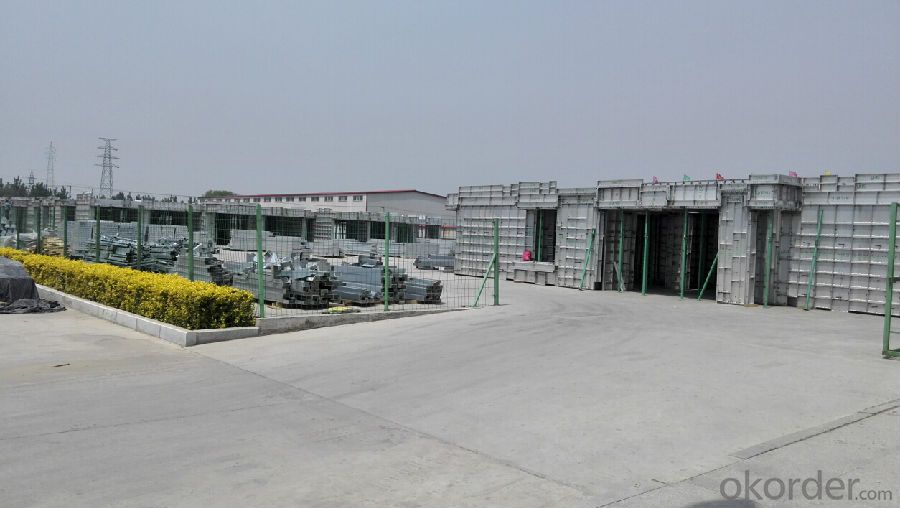
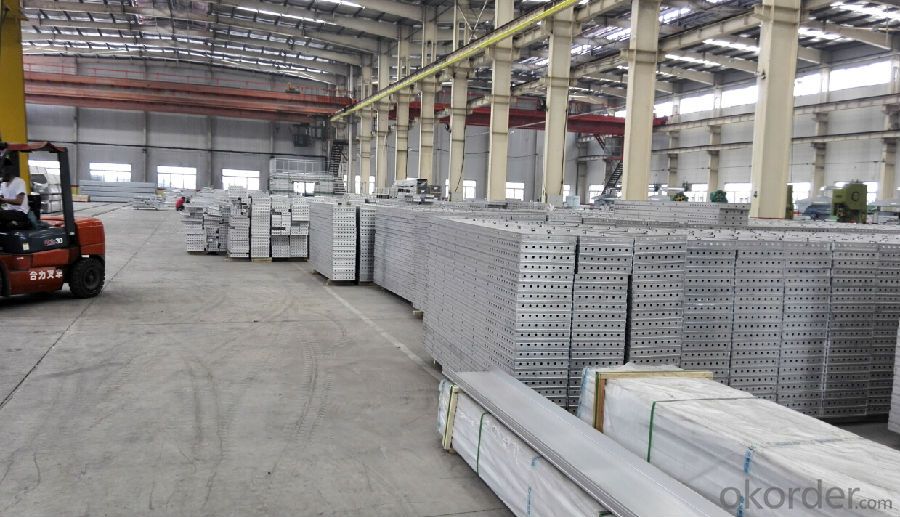
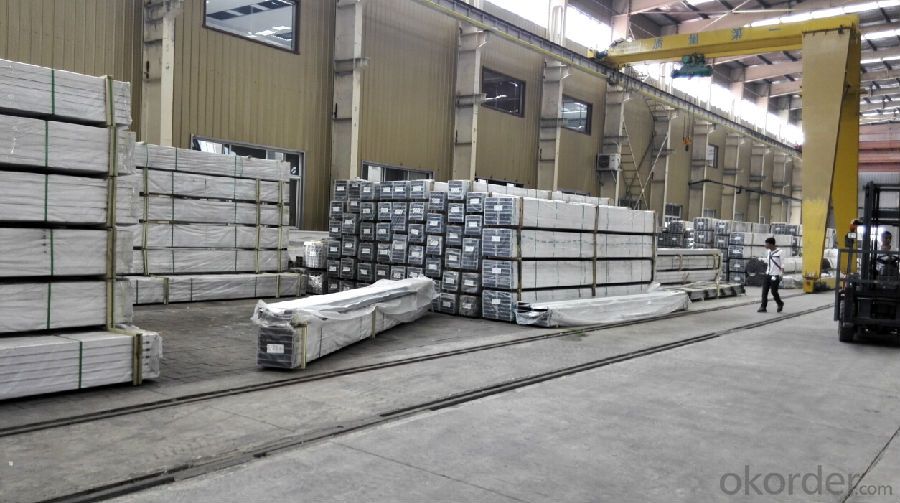
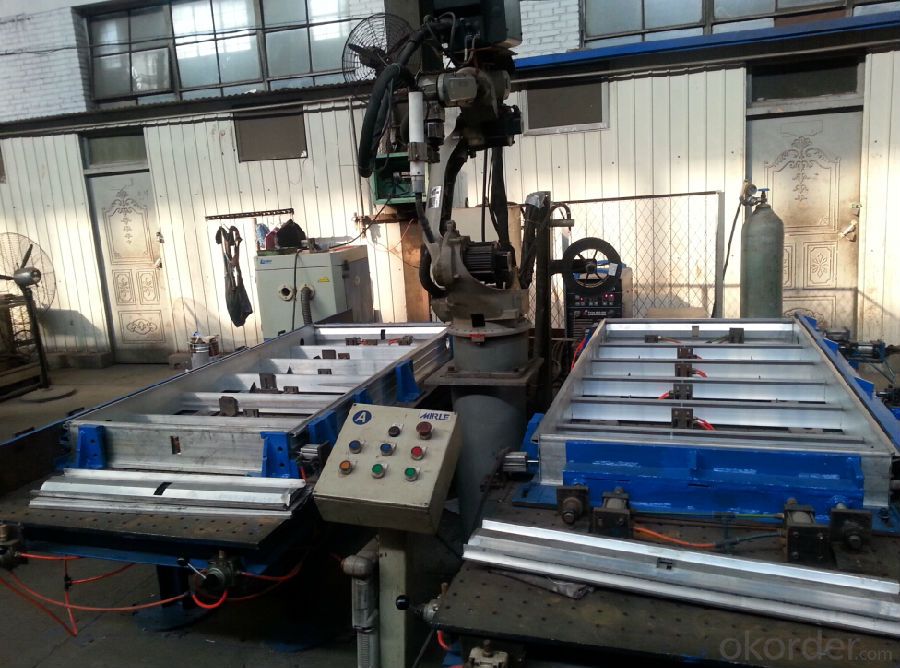
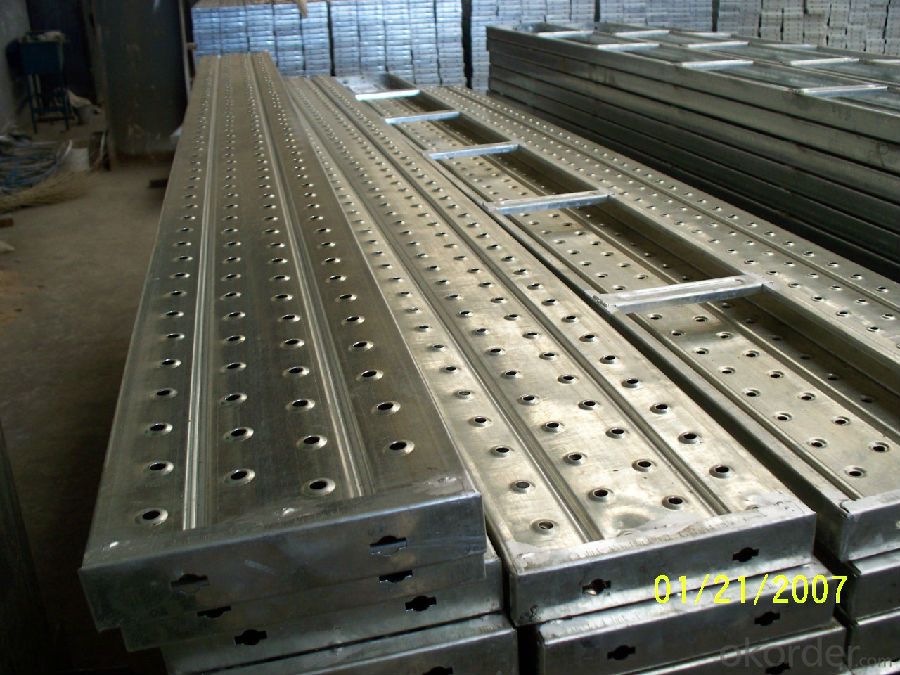
- Q: Can steel formwork be used for elevated helipads?
- Yes, steel formwork can be used for elevated helipads. Steel formwork is commonly used in construction projects to create temporary molds or structures to hold concrete in place until it hardens and gains strength. It is a versatile and durable material that can withstand heavy loads and provide the necessary support for elevated structures, such as helipads. Elevated helipads require a strong and stable foundation to ensure the safety of the landing and take-off operations. Steel formwork can be used to create the necessary support structure for the helipad, providing a solid base and ensuring that the concrete is poured and cured correctly. Steel formwork offers several advantages for elevated helipads. Firstly, it is highly resistant to deformation and can handle heavy loads, making it suitable for supporting helicopters. Additionally, steel formwork can be easily customized and adjusted to meet the specific design requirements of the helipad, allowing for flexibility in construction. Moreover, steel formwork is reusable, which makes it a cost-effective choice for construction projects. It can be dismantled and used for future projects, reducing waste and saving resources. In conclusion, steel formwork can indeed be used for elevated helipads. Its strength, stability, and versatility make it an ideal choice for creating the necessary support structure for safe and functional helipads.
- Q: What are the common design considerations for steel formwork in marine environments?
- When designing steel formwork for marine environments, there are several common considerations that need to be taken into account. These considerations are necessary to ensure the durability and longevity of the formwork in the harsh marine environment. Some of the common design considerations for steel formwork in marine environments include: 1. Material Selection: The selection of appropriate materials is crucial for withstanding the corrosive effects of saltwater. Stainless steel or other corrosion-resistant alloys should be used to prevent rusting and deterioration. 2. Coatings and Surface Treatments: Applying protective coatings or surface treatments can further enhance the corrosion resistance of the steel formwork. These coatings may include zinc-rich primers, epoxy coatings, or galvanization to provide an additional layer of protection. 3. Reinforcement and Strengthening: Marine environments can subject the formwork to significant forces such as waves, currents, and impact from floating debris. Reinforcement and strengthening measures, such as additional bracing or thicker steel sections, may be necessary to ensure structural integrity. 4. Drainage and Ventilation: Proper drainage and ventilation are crucial to prevent the accumulation of water, which can accelerate corrosion. Designing the formwork with appropriate drainage channels or weep holes can help remove any trapped moisture. 5. Connection Details: Special attention should be given to the connection details in marine environments. Corrosion-resistant fasteners, such as stainless steel bolts or galvanized screws, should be used to prevent premature failure due to corrosion. 6. Maintenance and Inspection: Regular maintenance and inspection are essential to identify any signs of corrosion or damage. Scheduled cleaning, removal of marine growth, and applying protective coatings as needed will help extend the life of the formwork. 7. Environmental Considerations: The marine environment is often subject to extreme conditions such as high winds, tidal forces, and exposure to UV radiation. The design should consider these factors to ensure the formwork can withstand these environmental loads. Overall, the design of steel formwork for marine environments necessitates careful consideration of material selection, coatings, reinforcement, drainage, connection details, maintenance, and environmental factors. By incorporating these considerations into the design process, engineers can ensure that the formwork will withstand the harsh marine conditions and provide a reliable and durable solution.
- Q: Can steel formwork be used for both horizontal and vertical concrete placement?
- Both horizontal and vertical concrete placement can utilize steel formwork. Steel formwork is a versatile and long-lasting solution for creating molds or frames that maintain wet concrete in the desired shape until it sets and hardens. This kind of formwork is frequently employed in construction projects for various purposes, including horizontal and vertical concrete placement. Steel forms possess enough strength to withstand the weight and pressure of the concrete, which renders them suitable for vertical applications like walls, columns, and beams. Moreover, steel formwork can be easily adjusted or modified to accommodate different shapes and sizes, making it perfect for horizontal placements such as slabs, floors, and pavement. In general, steel formwork offers flexibility, strength, and stability, making it suitable for a wide range of concrete placement requirements.
- Q: How does steel formwork compare to other types of formwork in terms of durability?
- Steel formwork is known for its exceptional durability compared to other types of formwork. Unlike wooden or plastic formwork, steel formwork is built to withstand heavy loads and repetitive use, making it ideal for projects that require long-term usability. Steel formwork is not affected by weather conditions, moisture, or decay, making it highly resistant to damage and deterioration. It can withstand extreme temperatures, strong winds, and heavy rains without compromising its structural integrity. This durability ensures that steel formwork can be used in various construction projects, including high-rise buildings, bridges, and tunnels, where strength and reliability are crucial. Another advantage of steel formwork is its ability to bear high concrete pressures. The robustness of steel allows it to handle the pressure exerted by wet concrete during the pouring and curing process. This makes steel formwork highly suitable for projects that involve pouring large volumes of concrete, ensuring that the formwork remains intact and can be reused multiple times. Furthermore, steel formwork has a longer lifespan compared to other materials. Due to its durability, it can be used for multiple construction cycles, reducing the need for frequent replacements. This not only saves time and money but also minimizes waste generated during construction. In summary, steel formwork surpasses other types of formwork in terms of durability. Its resistance to weather conditions, high concrete pressures, and long lifespan make it a reliable choice for construction projects that require a strong and long-lasting formwork system.
- Q: What are the different types of reinforcements used in steel formwork?
- There are various types of reinforcements used in steel formwork, including steel bars or rebars, wire mesh, steel plates, and steel fibers. These reinforcements are strategically placed within the formwork structure to enhance its strength, durability, and load-bearing capacity.
- Q: What are the different types of formwork ties used in steel formwork?
- Steel formwork systems commonly utilize various types of formwork ties to secure the formwork panels together and maintain the formwork structure's stability and strength. 1. The wedge tie, which is the most commonly employed formwork tie in steel formwork, involves inserting a wedge-shaped metal piece into a hole in the formwork panel. By tightening the wedge, a robust connection is established, firmly holding the panels in place. 2. The pin and wedge tie is another type of tie that consists of a pin and a wedge. The pin is inserted into a hole in the formwork panel, and subsequently, the wedge is driven into the pin, creating a tight connection. 3. The wing nut and tie rod tie system employs a wing nut and a tie rod to secure the formwork panels together. The tie rod is threaded through the panels and secured by wing nuts on both sides. This tie system allows for the convenient removal and reassembly of the formwork. 4. A coil tie is utilized when the formwork panels need to be fastened to the steel reinforcement bars. The tie is threaded through the formwork panel and then wrapped around the reinforcement bar, establishing a secure connection. 5. Flat ties are employed to tightly connect formwork panels in situations where a secure fit is required. These ties are flat metal strips inserted into holes in the formwork panels and then tightened. These examples illustrate only a few of the various formwork ties employed in steel formwork systems. The choice of tie depends on factors such as the specific formwork design, load requirements, and ease of installation and removal. It is essential to select the appropriate tie system to ensure the stability and safety of the formwork structure.
- Q: How does steel formwork affect the overall construction site organization?
- Steel formwork can greatly impact the overall organization of a construction site in several ways. Firstly, steel formwork is known for its durability and strength, allowing for faster and more efficient construction processes. This means that construction timelines can be significantly reduced, leading to better project management and improved site organization. Additionally, steel formwork systems are reusable, reducing waste and minimizing the need for additional materials and resources. This not only helps in streamlining the construction process but also contributes to a cleaner and more organized site. Furthermore, steel formwork offers flexibility in design and can be customized to fit various project requirements, enabling efficient utilization of space and better coordination among different construction activities. Overall, the use of steel formwork positively influences the overall construction site organization by enhancing productivity, reducing waste, and promoting better project coordination.
- Q: How does steel formwork affect the overall labor requirements of a construction project?
- Steel formwork can significantly reduce the overall labor requirements of a construction project. Its durability and strength allow for faster and more efficient construction processes, reducing the time and effort needed for assembling and disassembling formwork. Additionally, steel formwork is reusable, eliminating the need for repetitive formwork construction and reducing labor costs.
- Q: What are the common finishes available for steel formwork?
- There are several common finishes available for steel formwork, depending on the specific requirements of the project. Some of the most common finishes include: 1. Smooth finish: This is the most basic and commonly used finish for steel formwork. It provides a smooth surface that is suitable for most applications. 2. Textured finish: A textured finish can be achieved by using special form liners or by applying a textured coating to the steel formwork. This finish can add visual interest and provide a non-slip surface. 3. Galvanized finish: Galvanizing is a process of applying a protective zinc coating to the steel formwork. This finish provides excellent corrosion resistance, making it suitable for projects in harsh environments. 4. Powder-coated finish: Powder coating involves applying a dry powder to the steel formwork and then curing it with heat to form a protective layer. This finish offers durability, resistance to chipping and scratching, and a wide range of color options. 5. Painted finish: Steel formwork can also be painted to achieve the desired aesthetic appearance. Paint provides protection against corrosion and can be customized to match the project's design requirements. It is important to consider the specific project requirements, including the expected lifespan, environmental conditions, and aesthetic preferences, when selecting the appropriate finish for steel formwork. Additionally, it is recommended to consult with a structural engineer or a construction professional to determine the most suitable finish for a particular project.
- Q: How does steel formwork contribute to the overall cost-effectiveness of the construction process?
- There are several ways in which steel formwork contributes to the cost-effectiveness of the construction process. Firstly, the durability of steel formwork allows it to be reused multiple times, reducing the need for frequent replacements and lowering material costs. This durability also leads to reduced maintenance and repair expenses, further enhancing cost-effectiveness. In addition, steel formwork ensures precise and accurate construction due to its excellent dimensional stability. This reduces wastage of materials as the formwork provides a reliable template for the desired shape and size of the concrete elements, resulting in cost savings. Furthermore, steel formwork allows for faster construction cycles due to its easy assembly and disassembly. The interlocking panels and adjustable features make it quick and efficient to set up, saving time and labor costs. The seamless integration of steel formwork with modern construction techniques further enhances productivity and reduces construction time. Moreover, steel formwork offers flexibility and adaptability, allowing for customization and adjustments as per project requirements. This reduces the need for additional formwork or costly modifications, enhancing cost-effectiveness by avoiding unnecessary expenses. Additionally, steel formwork is known for its high strength and load-bearing capacity, eliminating the need for additional support structures. This reduces material and labor costs and provides a safe working environment. In conclusion, the use of steel formwork in construction projects contributes to cost-effectiveness through its durability, reduced material wastage, faster construction cycles, flexibility, and strength. By optimizing resources and enhancing efficiency, steel formwork helps minimize expenses, making it a cost-effective choice.
Send your message to us
Steel Formwork for Tunnel Building with thick Steel Plate
- Loading Port:
- Tianjin
- Payment Terms:
- TT OR LC
- Min Order Qty:
- 100 pc
- Supply Capability:
- 100000 pc/month
OKorder Service Pledge
OKorder Financial Service
Similar products
Hot products
Hot Searches
Related keywords
